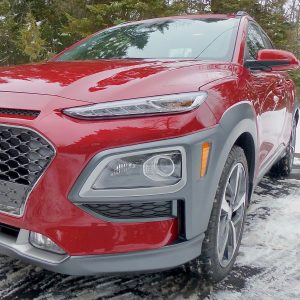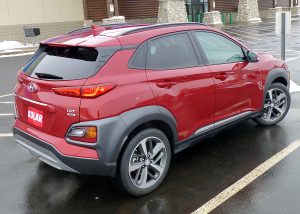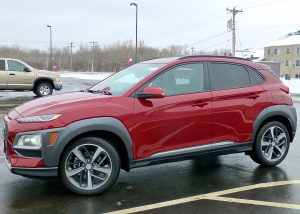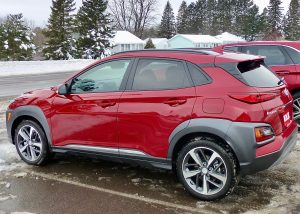High-tech, Low Price Make Kona New Car Pick of the Year
By John Gilbert
The Hyundai Kona has earned the unprecedented honor of being named the 2019 “New Car Pick of the Year,” satisfying both the nation’s insatiable appetite for SUVs with restraint provided by the rational input from those of us at the website newcarpicks.com.
Among the numerous impressive and worthy vehicles filling every automotive segment these days, there are a number of worthy attractions for car buyers. But U.S. consumers have turned away from the lengthy list of outstanding new sedans and choosing to go with SUVs, the contemporary version of what we used to know as station wagons. Decades ago, we moved on to minivans, then to large SUVs, before falling back a bit to more reasonably sized sport-utility vehicles.
Hyundai, the South Korean conglomerate that has spent less than a decade vaulting from a mediocre bit player in the economy car business to a sensational company that learned the secrets of high technology, styling, and mechanical wizardry and has combined them all into attractive and appealing vehicles.
With the larger Santa Fe and Tucson SUVs finding success above a battery of fine cars from subcompact to luxury, the Kona is in a unique position to blend advanced styling and safe structure into a compact SUV — called CUV, for Compact Utility Vehicle. It is the perfect combination of all-weather all-wheel drive in a compact package large enough to carry some people, some luggage and equipment and yet small enough to be maneuverable — dare we say sporty? — in traffic congestion or twisty road regions. All of it comes in at a price that is remarkably reasonable, from $20,000-$30,000, which is just about half of what slightly larger SUVs try to command, even though they don’t have nearly the technical features that virtually fill the Kona.
This selection has no connection with the North American Car, Truck and Utility of the Year named this week at the Detroit International Auto Show. I was a member of that august jury for about a decade and a half, starting back when I spent 30 years writing about sports and cars at the Minneapolis Tribune. The North American Car of the Year jury decided to expand from a car of the year to add a companion truck of the year, and three years ago it added a separate SUV category, further diluting its choices.
For the record, that group also named the Kona its Utility of the Year, joining the Ram 1500 as Truck of the Year, and the Hyundai G70 sedan as Car of the Year. It is nice timing that Hyundai just recently decided to branch its largest sedans off under the name of its Genesis sedan, so those who might discriminate may not even realize that Hyundai, from South Korea, just claimed two of the three biggest prizes at Detroit.
Those three winners had been predicted in this column a couple of months ago, although we at newcarpicks.com remained undeterred about naming just one vehicle Car of the Year and taking it on as a project for the coming year to verify the choice. While test-driving every new vehicle that I can get my hands on, we will have our own Kona to run through long-term testing, with my wife, Joan, keeping track of every expense and describing little tidbits of pleasure or nitpicks we can find from driving and living with the vehicle. Occasionally our sons, Jack and Jeff, will provide further input.

Array of lights include LED headlights, with foglights, driving lights and foglights separated stylishly on Kona’s front end.
The trend to go from cars to large SUVs never connected with us. My theory is “anything bigger than big enough is too big,” which was first aimed at gas-guzzling giant SUVs capable of hauling lots of large objects, even when you were commuting alone to work with no load.
Coming down to midsize SUVs made a lot more sense, and the recent surge of compact or crossover SUVs, built on efficient and economical car platforms, started proving to be viable alternatives to cars. The fact that the reduced price of regular gas reaching down to under $2.15 per gallon, was mere coincidence, although some companies were able to capitalize doubly because they were building much more efficient powertrains to take on the costlier fuel prices.
Now a fleet of compact SUVs or CUVs have captured the hearts of consumers, leading the way to the astounding fact that something like 72 percent of all the vehicles sold in 2018 were SUVs. No wonder Ford, General Motors and FCA are reducing the number of cars they build in favor of SUVs and pickups. When oil companies again find a way to raise prices, those who thought it was OK to buy larger and less efficient SUVs will unload them in a hurry for compact SUVs, which are almost as inexpensive to operate as compact cars. Of all of these, we think the Kona is the best new one, and a technological breakthrough besides.
The Kona comes in a variety of models, from the base SE, which starts with front-wheel drive, and a highly efficient 2.0-liter engine that delays valve opening by Atkinson cycle to give optimum economy with its 147 horsepower and 132 foot-pounds of torque. A 6-speed automatic and all-season tires on 16-inch alloy wheels make the SE look almost identical to the upscale models, and stability management and traction control, plus hill start assist and downhill braking control and all necessary connectivity makes it a bargain, bolstered by 33 mpg highway EPA estimates.
Moving up to the SEL, Kona adds 17-inch alloy wheels and a host of high-tech things, such as anti-theft immobilizer, blind-spot alert, lane-change assist, cross-traffic and side collision warning, push-button start, leather wrapped steering wheel and shift knob, heated front seats, HD and satellite radio and a hidden cargo area at the rear.
Move still higher and you get to the Limited, which accumulates all the SE and SEL features and adds the option of my favorite Hyundai engine — the 1.6-liter direct-injection 4-cylinder with a turbocharger, good for 175 horsepower and 195 foot-pounds of torque, operating through a 7-speed dual-clutch transmission.
The top-level Ultimate has all the attributes of the Limited, plus 18-inch alloy wheels, power tilt and slide sunroof, LED headlights and taillights, foglights, leather seats and automatic temperature control. Also standard on Ultim
All four models offer the option of all-wheel drive over the standard front-wheel drive. The small but potent turbo 1.6 has Hyundai’s own 7-speed dual-clutch transmission, in which two internal clutches alternate which one is engaged, with one handling first, third, fifth and seventh and the other shifting into second, fourth and sixth. You can do it manually, by moving the floor shift lever into the manual side, or you can let it shift for itself, precisely and swiftly.
We will devote our Car of the Year evaluations to the Ultimate model with AWD. We selected the Kona despite the obvious situation that the rear seat room is tight, compared to larger midsize SUVs. Son Jack climbed back there, and at 5-foot-10, he declared it to be a bit tight climbing in, but once inside, it was adequate for head and legroom and surprisingly comfortable. We could say the same, for certain, about the leather front bucket seats, very supportive and comfortable.
Within the overall length of 164 inches, the Kona has 39.6 inches of front headroom dropping to 38 inches with the power sunroof, with rear headroom of 37.8, and front legroom of 41.5 inches with 34.6 inches in the rear. Cargo capacity is a modest 19.2 cubic feet with all seats in place, expanding to 45.8 with the rear seats folded down.
Among the Star-Wars-y features is the Blue Link, which allows us to program the car’s connectivity with our iPhones. You of course can use the key fob to lock and unlock the doors or pop the rear hatch, but you’ll want to download the free Hyundai app. Summon it, and you can lock, unlock, open the hatch, and also activate the auto-start by clicking the proper icon and executing by Wi-Fi!
In Duluth, Minnesota, where the all-wheel drive works wondrously on all the hills, being able to fire up the car for a warm-up of up to 10 minutes is greatly appreciated when the temperature occasionally dips below zero. There are stories such as the woman leaving her key fob in the console and realizing it as she headed out into the cold. She called her husband, who was out of town on business and explained her predicament. No worries. He used his iPhone to lock the doors and remotely start the car, a couple hundred miles away, and set the interior temperature to 71 degrees. She walked to the car and called him again, and he unlocked the car from long-distance and she got in and drove away.
There are other manufacturers that build such features into their vehicles, but generally they cost at least twice as much as the Kona. Being a person who loves high-tech gadgetry but also is always looking for a bargain, finding the Kona with all those features for under $30,000 made it the overwhelming choice as our Newcarpick of the Year.






 John Gilbert is a lifetime Minnesotan and career journalist, specializing in cars and sports during and since spending 30 years at the Minneapolis Tribune, now the Star Tribune. More recently, he has continued translating the high-tech world of autos and sharing his passionate insights as a freelance writer/photographer/broadcaster. A member of the prestigious North American Car and Truck of the Year jury since 1993. John can be heard Monday-Friday from 9-11am on 610 KDAL(www.kdal610.com) on the "John Gilbert Show," and writes a column in the Duluth Reader.
John Gilbert is a lifetime Minnesotan and career journalist, specializing in cars and sports during and since spending 30 years at the Minneapolis Tribune, now the Star Tribune. More recently, he has continued translating the high-tech world of autos and sharing his passionate insights as a freelance writer/photographer/broadcaster. A member of the prestigious North American Car and Truck of the Year jury since 1993. John can be heard Monday-Friday from 9-11am on 610 KDAL(www.kdal610.com) on the "John Gilbert Show," and writes a column in the Duluth Reader.